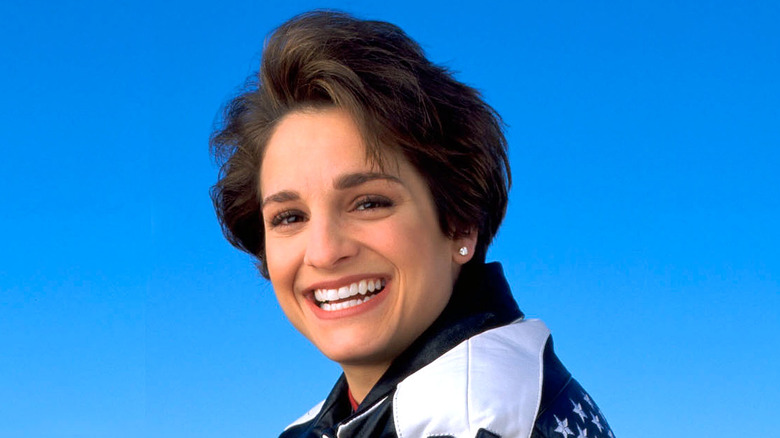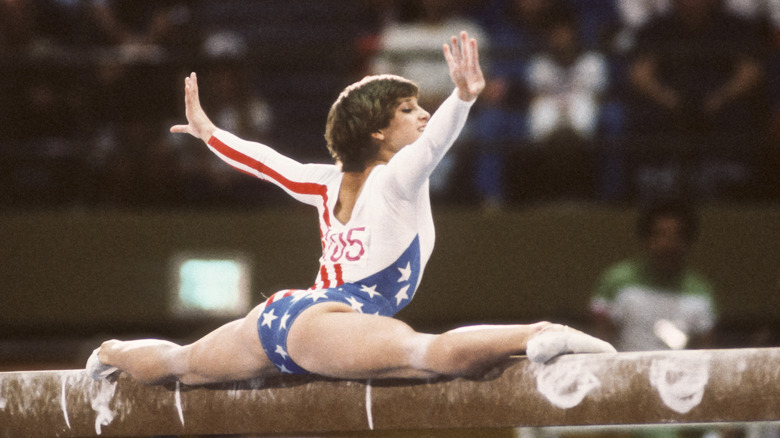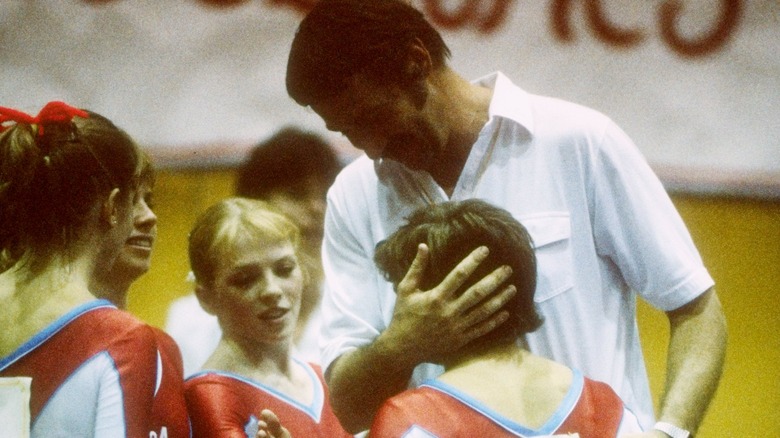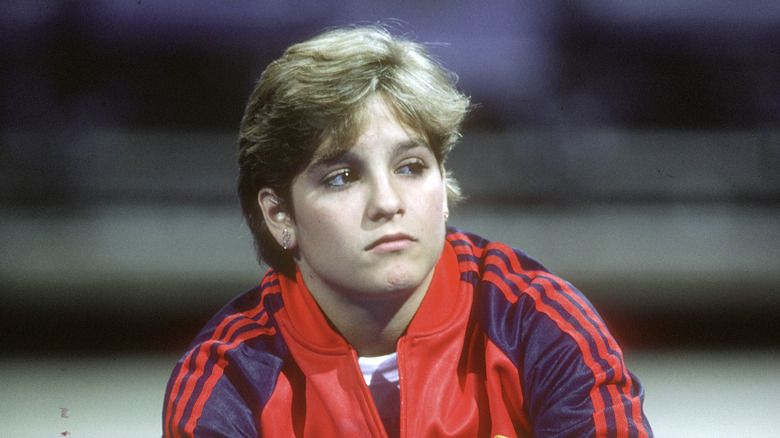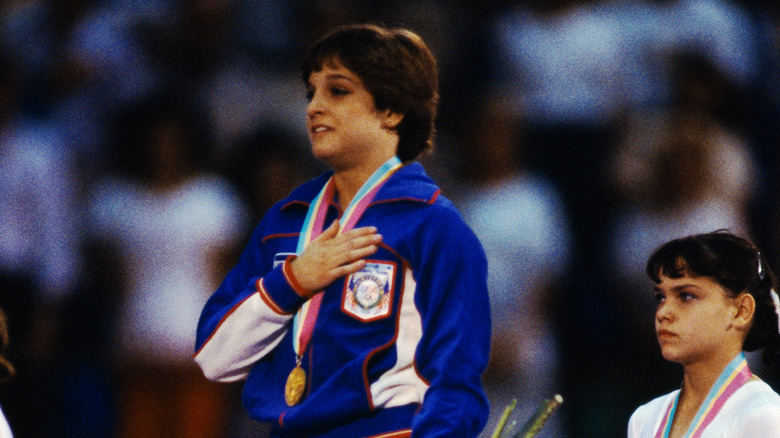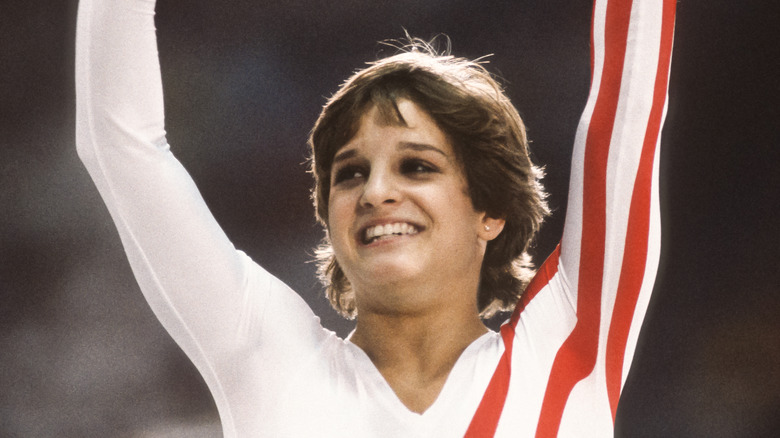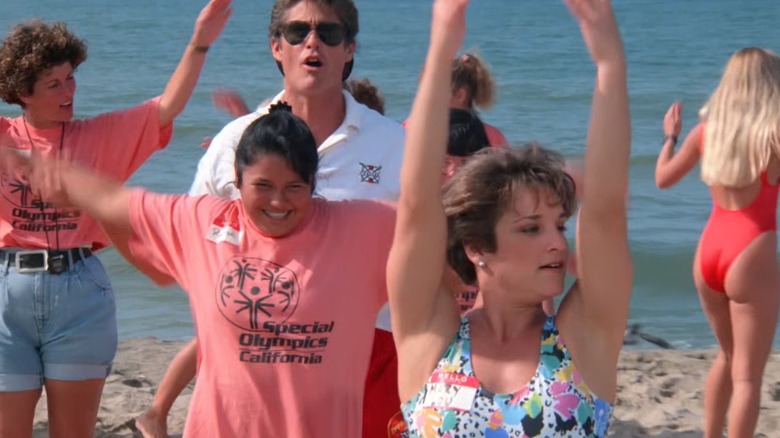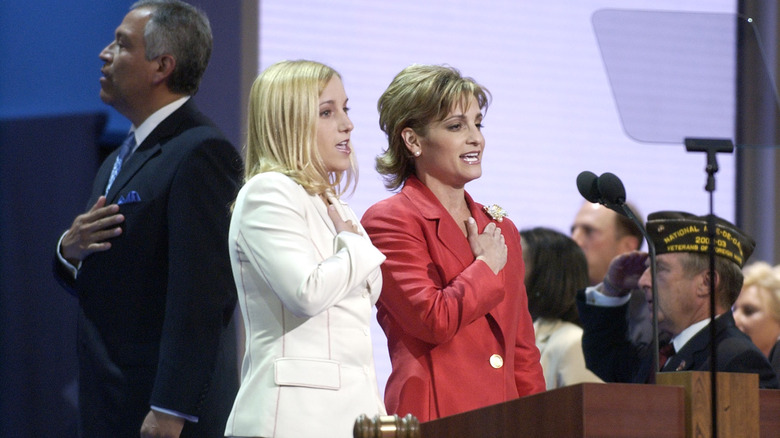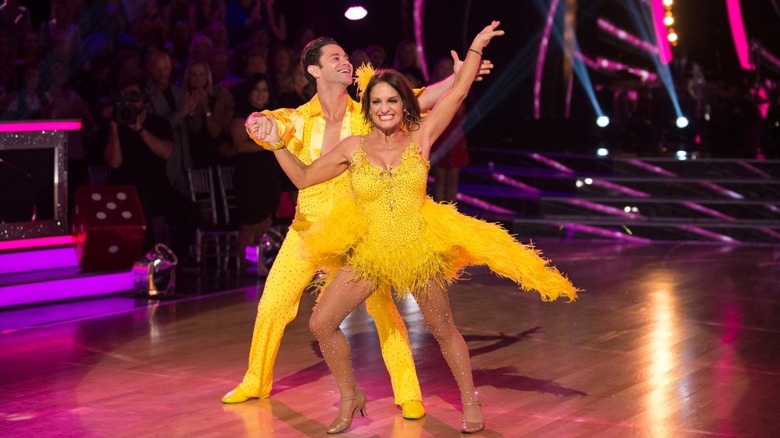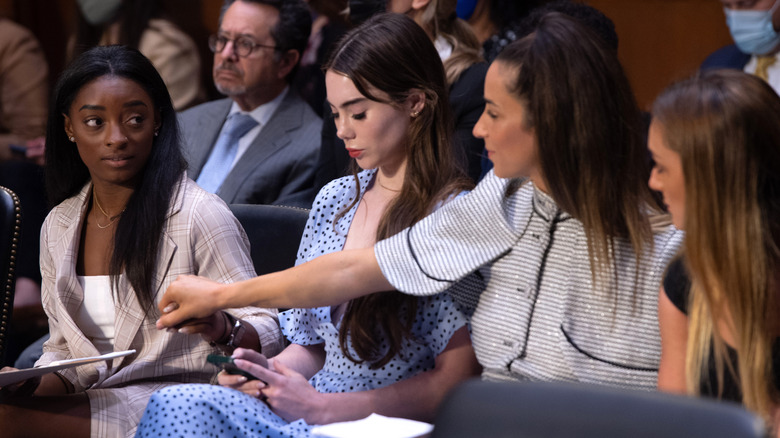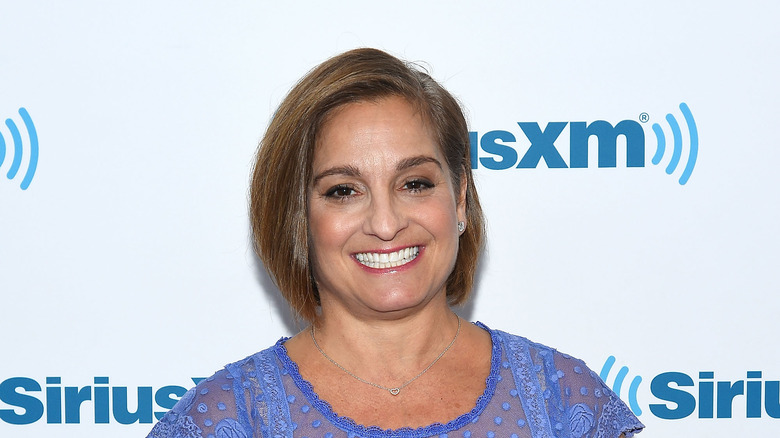The Untold Truth Of Mary Lou Retton
Mary Lou Retton was dubbed America's sweetheart when she became the first American female gymnast to win gold in the all-around competition during the 1984 Olympics. In the months and years that followed, the diminutive teen with a camera-ready smile became a poster girl of sorts, not just for Wheaties cereal, but for her sport and her country. Even those who didn't follow gymnastics recognized her name and face, and decades after her historic victory, she's still associated first and foremost with her podium-worthy performance in Los Angeles.
But, despite having reached the absolute pinnacle of her sport, Retton's career as a gymnast accounts for a surprisingly small part of her biography. Her rapid rise within the world of gymnastics was followed by just as abrupt a departure, and she's spent the majority of her personal and professional life pursuing other endeavors. Yes, she scored that perfect 10 to beat Romania's Ecaterina Szabo in a made-for-TV moment. Yes, she was named Sports Illustrated Sportswoman of the Year and was, for a time, the most popular athlete in America. Still, there's more to Mary Lou Retton than even her most adoring fans probably know. The full story of this former champion's life is as loaded with as many twists, turns, and high stakes as were her thrilling routines.
She was born with bad hips
Since birth, Mary Lou Retton has dealt with a medical condition that might seem like an advantage to a potential gymnast. In truth, that condition sentenced her to a lifetime of pain and invasive treatment, beyond even that of what most professional athletes have to contend with. Retton was born with hip dysplasia, a malformation in which the socket of the hip joint doesn't entirely cover the ball of the femur, per Boston Children's Hospital. As a result, the hips can overextend or, in some cases, dislocate. Hip dysplasia affects girls, like Retton, more often than boys and is usually treatable, especially if diagnosed early in childhood.
Today, hip dysplasia is often medically identified in the first year of a child's life. Unfortunately for Retton, hers went undiagnosed, and the years of wear and tear that she put on her body as an elite athlete didn't help matters. Her chronic pain was a mystery until well into adulthood and after her days as an athlete were over. By that point, Retton required a total replacement of both hips. The former Olympic champion, who was so strong and agile that she had a gymnastics move named after her (the Retton flip), had to relearn basic motor skills like sitting and walking throughout months of intensive physical therapy. Retton was no stranger to the recovery process. In total, between her bad hips and her body-battering time at the gym, she's undergone 19 surgeries on her 4' 9" frame.
She sacrificed her education for athletic greatness
Many American children participate in sports during their elementary and high school years, with hopes of making it big after graduation. Exceedingly few actually get that opportunity, and even fewer get it while they're still a young teenager. Mary Lou Retton had the talent, but the window in which gymnasts can achieve greatness is so narrow that she was forced to choose between her education and her promise as a world-class athlete.
Retton took up dance and tumbling when she was just four years old. At seven, she was starting to show promise in gymnastics school, and when Comaneci's coach, Bela Karolyi, left Romania for the United States in 1981, Retton's parents made a bold decision. During her freshman year at Fairmont Senior High School, they withdrew their daughter and moved her — alone — from rural West Virginia to Houston, Texas, so that she could train with Karolyi and the best of the best full-time.
For the better part of two years leading up to the 1984 games, Retton's priority was to get stronger and learn new skills. This came at the expense of the distance-learning courses she was supposed to be completing, not to mention normal teenage experiences like going to the prom. "It's a tradeoff," she told Sports Illustrated in 1984. Retton went on to win five Olympic medals, but rather than graduate with her class at Fairmont, she had to earn her GED on her own time.
She nearly missed the 1984 Olympics because of an injury
Some of the most dramatic moments in sports history — and in gymnastics in particular — have occurred when a superstar sustains an injury and has to play or perform through the pain. That was the case for Mary Lou Retton in 1984, though not everybody in the audience or at home knew what she was up against, so there was none of the usual in-the-moment heroism. Just five weeks before she was set to appear in the Olympics, Retton had trouble getting up off of the floor while signing autographs and suspected that she'd done damage to her knee. She had hoped she'd be able to ice it and continue her training, but doctors broke the news that surgery was her only option to repair the broken piece of cartilage.
"I was hysterical," she told the Los Angeles Times. Though she was only 16 years old, she'd been working for more than a decade toward the goal of competing on the world stage, and she was already feeling the pressure to win hardware for her country. After an arthroscopic procedure successfully fixed the knee, Retton faced what is meant to be a three-month long recovery process with only three weeks left until the games began. She worked hard to get back to where she'd been before the injury, and as her Olympic record shows, she not only made it back to the floor, beam, bars, and vault, but dominated the competition.
Her all-around gold came with an asterisk
That Mary Lou Retton became the first-ever American woman to win the gold medal in an Olympic all-around gymnastics competition is, undeniably, an impressive feat. Her first-place finish made her a beloved sports celebrity at the time, and she remains an icon to many fans of the sport today. But not everyone in the world of gymnastics saw it that way. Her victory carries some controversy, given the state of international gymnastics competition and international politics in the 1980s.
The previous Olympic Games had been held in 1980 in Moscow, and the Russians had upstaged the Americans, winning 80 medals. Those games were especially competitive; a whopping 36 world records were broken. Four years later, in Los Angeles, Russia and 14 other Eastern European countries were boycotting the Olympics because of perceived political hostility. Anecdotally, the Los Angeles games were seen as being more hospitable toward American athletes when it came to scoring, and without some reigning champions returning to defend their titles, fewer records were set. Retton, for example, didn't have to compete against Natalia Yurchenko, the 1983 world all-around champion.
Still, the Olympic Games are the Olympic Games, and Retton refuses to see her accomplishments as lesser than. She told The Washington Post, "[The boycott] doesn't take any value away from my medal."
She went out on top
Because of the strain on their bodies and the fact that they enter competition well before adulthood, professional female gymnasts tend to retire young. Mary Lou Retton's career was fleeting even by those standards. Retton was just 14 years old when she began to take the sport more seriously, around the time she began training with Bela Karolyi in Houston, and was just 18 years old when she somewhat unexpectedly retired from the sport, two years before the 1988 Summer Olympics in Seoul, South Korea.
Retton had been affected by injuries, but her exit didn't necessarily have to do with any physical obstacles. After the Los Angeles Games, she competed in the 1985 American Cup, where she won all four individual events and the all-around title for the third year in a row. Her coach thought she should attempt to defend her Olympic gold. "I was of the strong belief that she should go further, into the '88 Games," he told The Washington Post. But Retton hung up her leotard at the height of her success. Her reason? She'd become a celebrity, and managing her schedule of appearances and autograph signings was becoming as difficult as keeping up with her training. Going out on top also helped to preserve her public image as a champion.
She transitioned to a career on screen
Mary Lou Retton capitalized on her Olympic gold and turned her winning reputation as a gymnast into a second act as a spokesperson, commentator, and performer. Her agent at the time, John Traetta, said of Retton to The Washington Post, "She has evolved into a personality who's more than a sports figure." The exposure of the Olympics, combined with her youth and enthusiasm, made her a broadly popular figure to audiences outside of the world of gymnastics. Besides gracing the Wheaties box, smiling under the phrase, "The Breakfast of Champions," Retton also signed contracts with Vidal Sassoon hair products, Pony shoes, Humana Hospitals, and the National Bowling Council ... and that was just in the years immediately following her retirement.
Retton was also a natural fit for sports broadcasting. She did end up attending the 1988 Seoul Games, after all, just as on-air talent for NBC. It was a role she returned to for the 1996 games in Atlanta. In addition, she regularly hosted NBC's Olympics-related special coverage, and ventured into narrative film and television as well. She appeared, mostly as herself in cameos, in TV shows such as "Knots Landing," "Baywatch," and "Dream On," and in movies such as "Scrooged" and "Naked Gun 33 1/3: The Final Insult." She also participated as a celebrity contestant on game shows like "The New Hollywood Squares," "Weakest Link," and "Who Wants to Be a Millionaire?" And in 2018, Retton was a cast member on the 27th season of "Dancing with the Stars." Though she'll be remembered for her incredible flips and twists, she's spent far more of her professional life in media and advertising.
She's quietly active in the church and republican politics
Even though the Soviet Union wasn't contesting the games in Los Angeles, Mary Lou Retton's 1984 Olympic wins were a symbolic victory for the United States during the Cold War era. Clad in the stars and stripes and holding her hand over her heart as the National Anthem played, Retton became synonymous with patriotism. When then-President Ronald Reagan was photographed with the American team, the petite gymnast was front and center, and wrapped under the Commander in Chief's arm. She was subsequently featured in his re-election campaign, and remained active in republican politics through at least 2004. She and fellow former gymnastics star Kerri Strug were guests at the GOP convention in New York City, during which George W. Bush was again chosen as the party's nominee. Together, they recited the Pledge of Allegiance during the live broadcast. Retton was also one of the professional athletes who signed a letter of support for Presidential Bush.
Though she was taught not to discuss politics and religion, and was especially hesitant to as a young public figure, as Retton aged from a cute teen into a hard-working mom, she grew more comfortable talking about how her faith informed her life. She was raised in a religious home, but became more involved in the church when she was raising a family of her own. "I've realized that I need to set that example in a more vocal way, in a public way — for my daughters," she told Baptist Press. "And part of being a Christian is getting the word out."
She kept her divorce quiet ... until she didn't
After moving away from her parents and siblings to train full-time, Mary Lou Retton prioritized marriage and motherhood during her post-gymnastics life. She wed former college football player Shannon Kelley in 1990; the two met at the University of Texas where Kelley was the quarterback and Retton was taking some classes. The athletically gifted couple went on to have four daughters: Shayla, McKenna, Skyla, and Emma.
Retton's busy but fulfilling family life was a frequent topic in her motivational speeches. But, ironically, all that time spent on the road inspiring others (upwards of 15 days a month) was part of what eventually drove her and Kelley apart. Retton admitted that her speaking engagements and sponsorship deals put strain on her relationship (per Baptist Press), and the couple divorced in February 2018 after 27 years of marriage. But Retton didn't share that information with the public at large until November of that year, during the episode of "Dancing with the Stars" in which she and her partner, Sasha Farber, were eliminated.
"I'm not one to air my dirty laundry, " Retton told People, "but for the entire show I kept talking about struggles and challenges and how I lost myself and all of that." The gymnast-turned-ballroom dancer said she wanted to be transparent with her fans without appearing to bash her ex-husband. She hoped that opening up about the decision to end her long marriage might help other women in similar situations.
She tried to block legislation to protect young gymnasts
Though Mary Lou Retton was one of gymnastics' brightest stars, her legacy was tarnished by her stance during the sexual abuse scandal that rocked the sport. Beginning in 2014, women treated by Team USA doctor Larry Nassar began coming forward with allegations that he'd touched them inappropriately during physical examinations.
In the years that followed, hundreds of victims provided statements against Nassar, who eventually lost his job at Michigan State University as well as his medical license, and is currently serving a lengthy prison sentence. However, his accusers — including superstars Simone Biles, Aly Raisman, and McKayla Maroney — weren't satisfied that what they saw as a systemic problem had been solved. They suspected that the powers that be within the sport knew about the abuse and could've stopped it sooner.
They were right. As it turned out, there were 54 complaints on file with USA Gymnastics. With the victims' support, Senator Dianne Feinstein of California introduced the Protecting Young Victims from Sexual Abuse and Safe Sport Authorization Acts to Congress in 2017, which was intended to make it a federal crime not to report suspected abuse within athletic organizations. The gymnastics federation offered sympathy to the victims, but didn't officially apologize and fought Feinstein's proposed measures. Retton sided with USA Gymnastics and described the environment within the sport as "happy" and "safe." The bill passed, regardless of Retton's testimony and opposition.
If you or anyone you know has been a victim of sexual assault, help is available. Visit the Rape, Abuse & Incest National Network website or contact RAINN's National Helpline at 1-800-656-HOPE (4673).
She's currently facing a health crisis
Most recently, Mary Lou Retton has been in the news because of a serious health scare. In October, Retton's daughters took to the internet to share that their mother had been hospitalized. "My amazing mom, Mary Lou, has a very rare form of pneumonia and is fighting for her life," McKenna Kelley wrote on the crowdsourcing platform, Spotfund (via The Mercury News). She added that Retton was currently in the ICU and wasn't able to breathe on her own, but declined to provide further details out of respect for what she called her family's privacy.
While it's certainly shocking to think of the physically gifted Retton, who's only 55 years old, in such a vulnerable and precarious position, health-wise, it was even more shocking for the world to learn that the celebrity athlete and media personality was uninsured. To cover her medical expenses, her daughters set up an online campaign to raise $50,000. The fundraising effort quickly exceeded its goal thanks to Retton's many concerned fans.
But just as many internet users were put off by what they perceived to be a choice not to have health insurance. They pointed out that Retton had acquired millions in endorsement deals and speaking fees over the years, and currently lives in what many people would consider to be a luxury home. As of the time of writing, Retton's daughters have provided an update on Instagram. They said their mother is improving, responding to treatment, and relying on breathing machines less, and thanked her fans for their love and support.
